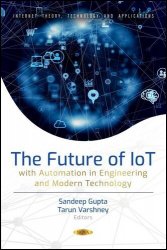The Future of IoT with Automation in Engineering and Modern Technology
- Добавил: literator
- Дата: 20-06-2024, 01:11
- Комментариев: 0
 Название: The Future of IoT with Automation in Engineering and Modern Technology
Название: The Future of IoT with Automation in Engineering and Modern TechnologyАвтор: Sandeep Gupta, Tarun Varshney
Издательство: Nova Science Publishers
Серия: Internet Theory, Technology and Applications
Год: 2024
Страниц: 374
Язык: английский
Формат: pdf (true)
Размер: 32.5 MB
The purpose of this book is to serve as a forum in which academics and researchers from all over the globe may come together to communicate, promote, and debate numerous new challenges and advancements in many fields related to engineering applications and the Internet of Things (IoT). One of the key benefits of automation offered by IoT is a large reduction in operational expenditures. It is one of the most significant advantages in terms of productivity and efficiency. Information is shared between different types of hardware in order to make it possible to automate processes and eliminate the need for human interaction. Industrial automation needs to be able to self-organize, self-configure, and expand to vast scales, all while consuming very little power, being inexpensive, and being based on a worldwide standard. This book presents the Internet of Things for fleet management, which helps in geolocation, performance analysis, telemetry control, fuel savings, pollution reduction, and vehicle driving. This book is a collection of ideas that looks at how things are connected to the Internet and how it might help people stay connected.
Chapter 1 - The Internet of Things (IoT) refers to a framework where physical objects are equipped with sensors, actuators, and microcontrollers to enable communication and accomplish specific purposes. This section aims to cultivate a user’s understanding of the IoT system by exploring their beliefs and the key factors associated with it. Additionally, it categorizes IoT applications based on services across personal, business, and public domains, delving into the perception model of IoT within various sectors.
Chapter 2 - This chapter examines the role of Artificial Intelligence (AI) in the context of the Internet of Things (IoT) and automation. It explores the intersection of AI and IoT, highlighting how AI enhances the capabilities of IoT devices and presents real-world examples of AI-powered IoT applications. The chapter delves into various AI techniques, including Machine Learning algorithms, deep learning models, and natural language processing, and their specific applications in the realm of IoT and automation. Furthermore, the chapter explores the impact of AI-enabled automation in industrial IoT, discussing key areas such as robotics, predictive maintenance, quality control, and supply chain management.
Chapter 3 - The Internet of Things (IoT) and smart cities are topics covered in this chapter. In the first section, the idea of the Internet of Things (IoT) is introduced, along with how it has the potential to alter urban environments by supplying real-time data that can be utilized to enhance services and optimize resource utilization. The next section of the chapter explores the essential elements of a smart city, such as intelligent infrastructure, efficient transportation, and high-quality public services, as well as how IoT technology may be used in each of these areas. Additionally, the chapter discusses some of the difficulties that must be overcome when deploying IoT in smart cities, including data security and privacy, interoperability, and scalability.
...
Chapter 10 - A three-tier home entrance security system using IoT, and image processing is presented in this chapter. In the authors’ proposed system, the authors develop a method for face detection using the haar cascade frontal face feature detection and recognition using the KNN algorithm. The authors obtained some simulation results using PyCharm. In this research work, the authors can achieve Tier 1. To accomplish Tier 2, the authors also designed a remotely accessible door lock system using IoT, which can be controlled using the Blynk app, and a surveillance device using a PIR sensor for intruder detection, which is Tier 3 of this project. The authors’ proposed system consists of a Raspberry Pi 4 B+, a Raspberry Pi camera, a node MCU, a solenoid lock, and a PIR sensor. The Node MCU is a microcontroller used to control the relay remotely, the relay switches for the solenoid lock, and the PIR sensor.
Chapter 11 - The exponential progress of the Internet of Things (IoT) has presented novel opportunities for transforming electricity distribution systems. Smart grids have become a crucial solution due to the rising integration of renewable energy sources, the increasing demand for electric vehicles, and the necessity for effective energy management. Nevertheless, the traditional centralized structure of smart grids encounters certain obstacles in relation to scalability, latency, and privacy. This study investigates the potential of edge and fog computing based on the Internet of Things (IoT) in revolutionizing smart grids by effectively tackling the aforementioned difficulties. Edge computing involves localization of computational capabilities close to edge devices, but fog computing expands upon this concept by extending the computational capabilities to intermediate fog nodes. The integration of edge and fog computing facilitates decentralized processing, instantaneous data analysis, and localized decision-making within the framework of intelligent power grids. Machine Learning and data analytics techniques will be employed to enable real-time monitoring, predictive maintenance, load balancing, and demand response in the smart grid system.
Скачать The Future of IoT with Automation in Engineering and Modern Technology
Внимание
Уважаемый посетитель, Вы зашли на сайт как незарегистрированный пользователь.
Мы рекомендуем Вам зарегистрироваться либо войти на сайт под своим именем.
Уважаемый посетитель, Вы зашли на сайт как незарегистрированный пользователь.
Мы рекомендуем Вам зарегистрироваться либо войти на сайт под своим именем.
Информация
Посетители, находящиеся в группе Гости, не могут оставлять комментарии к данной публикации.
Посетители, находящиеся в группе Гости, не могут оставлять комментарии к данной публикации.
